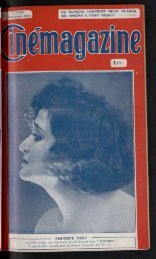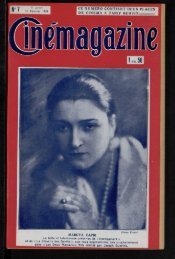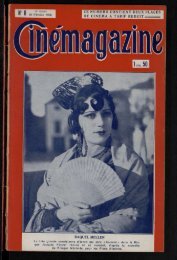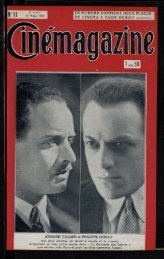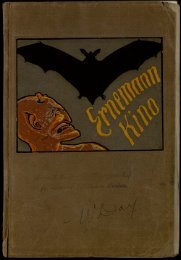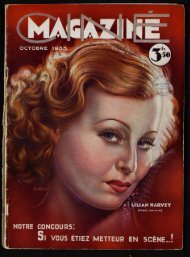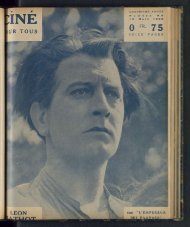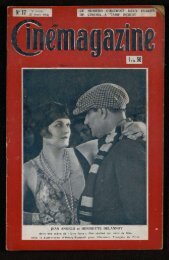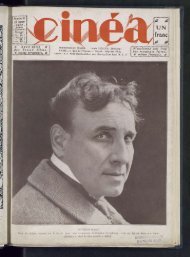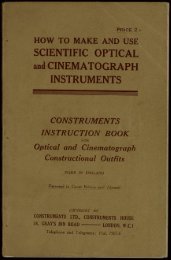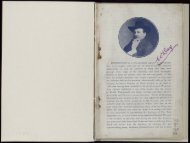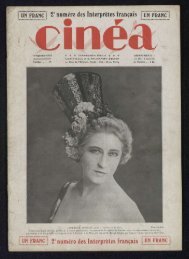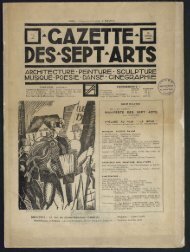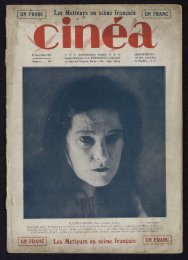Untitled
Untitled
Untitled
Create successful ePaper yourself
Turn your PDF publications into a flip-book with our unique Google optimized e-Paper software.
4<br />
MODERN MAGIC LANTERNS.<br />
employed to bring the light proceeding through the condenser<br />
and slide to a focus upon the screen, as will be<br />
explained hereafter ; and the brightness of the picture<br />
depends also upon the proportion of the light passing<br />
through the slide which the objective, or front lens as it is<br />
often called, allows to pass. This will be best seen by<br />
reference to Fig. 2, which represents the optical system of a<br />
lantern, and the course taken by the light in its passage to<br />
the screen. The letters are the same as in Fig. 1, F being<br />
the slide. Photographers will have no difficulty in understanding<br />
that if the lens, E, is one which would be described<br />
as a " slow " one, it would not allow so great a proportion<br />
of the light to pass as a " faster " lens.<br />
All these points have to be taken into consideration in<br />
deciding what instrument to employ for any given work.<br />
With good condenser and objective, probably the following<br />
summary will be a sufficient guide :<br />
For discs not exceeding eight feet in diameter, or for<br />
enlarging on bromide papera good petroleum lamp.<br />
For discs not exceeding twelve feetan oxy-calcium or<br />
" blow-through" jet, which is besides preferable to the foregoing<br />
for enlarging purposes, when circumstances permit.<br />
For larger discsthe mixed jet or the electric arc light.<br />
A lantern for all-round work, such as an amateur photographer<br />
would desire, is best fitted with a blow-through<br />
jet, or if this is impracticable, a three- or four-wick petroleum<br />
lamp.<br />
CHAPTER II.<br />
Cif /Lamps.<br />
NEARLY all the old-fashioned lanterns in use before the<br />
introduction of petroleum as an illuminant depended upon<br />
sperm or colza burnt in an Argand lamp, the construction<br />
of which can be gathered from Fig 3.<br />
The wick in these lamps is cylindrical,<br />
with an air passage in the<br />
centre as well as outside ; the tank<br />
for the oil is seen at the back of the<br />
figure, carrying in front of it the<br />
silvered reflector.<br />
The glass chimney for such lamps<br />
should taper towards the top, and<br />
the wick must be of loose cotton,<br />
the compact wicks employed for petroleum<br />
being of no use whatever for<br />
sperm or colza. Petroleum cannot<br />
be employed in this form of lamp ;<br />
sperm is preferable to colza, and<br />
much longer time must be given for<br />
the wick to get saturated with oil<br />
Fig. 3.<br />
OLD TYPE OF SPERM than in the case of petroleum. We<br />
OR Col,. LAMP.<br />
might add here, that it is not advisable<br />
with any lamp to saturate<br />
the wick before inserting it, as it is impossible to avoid<br />
messing up the outside with oil by so doing, a thing<br />
which should always be guarded against.



